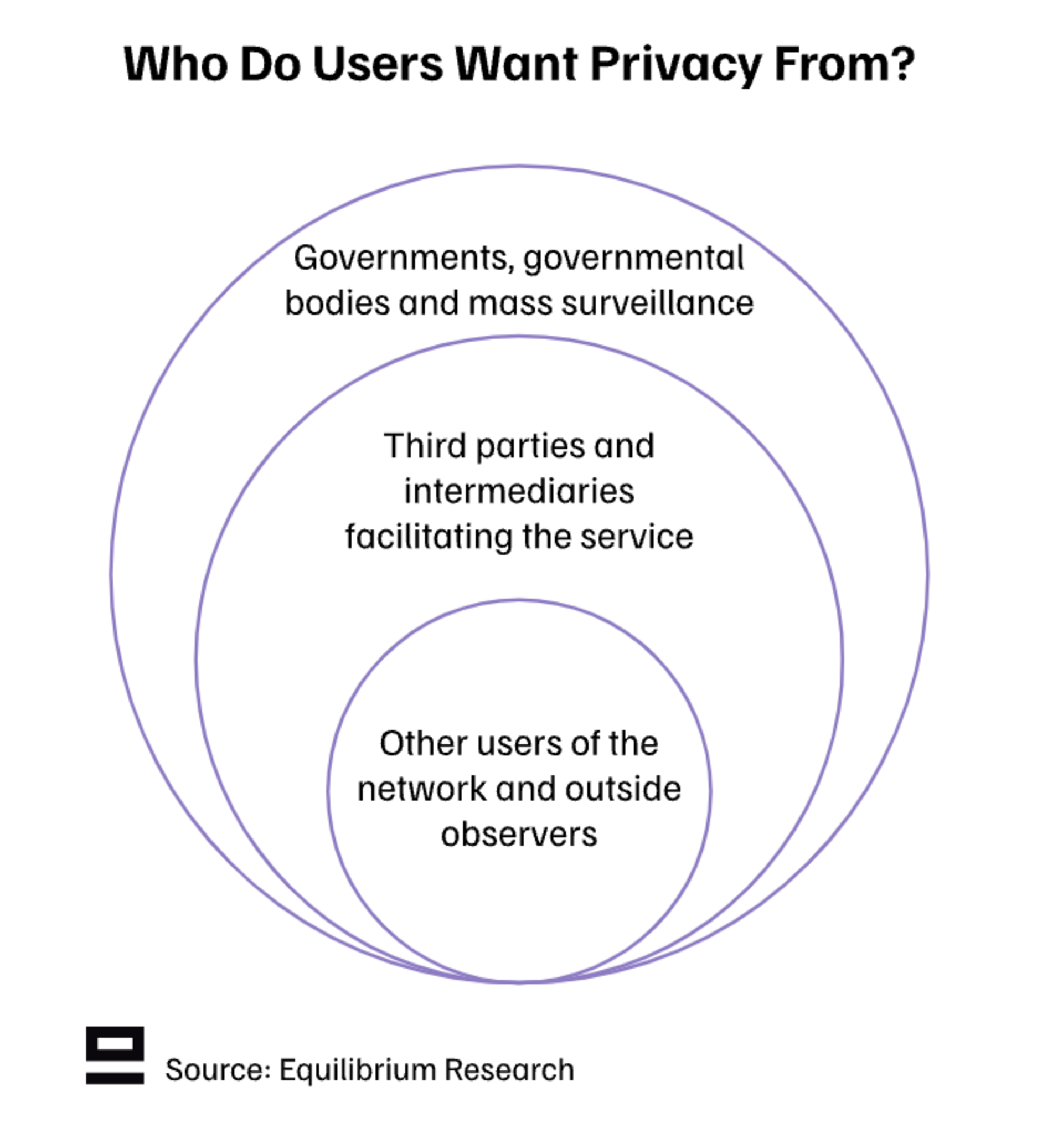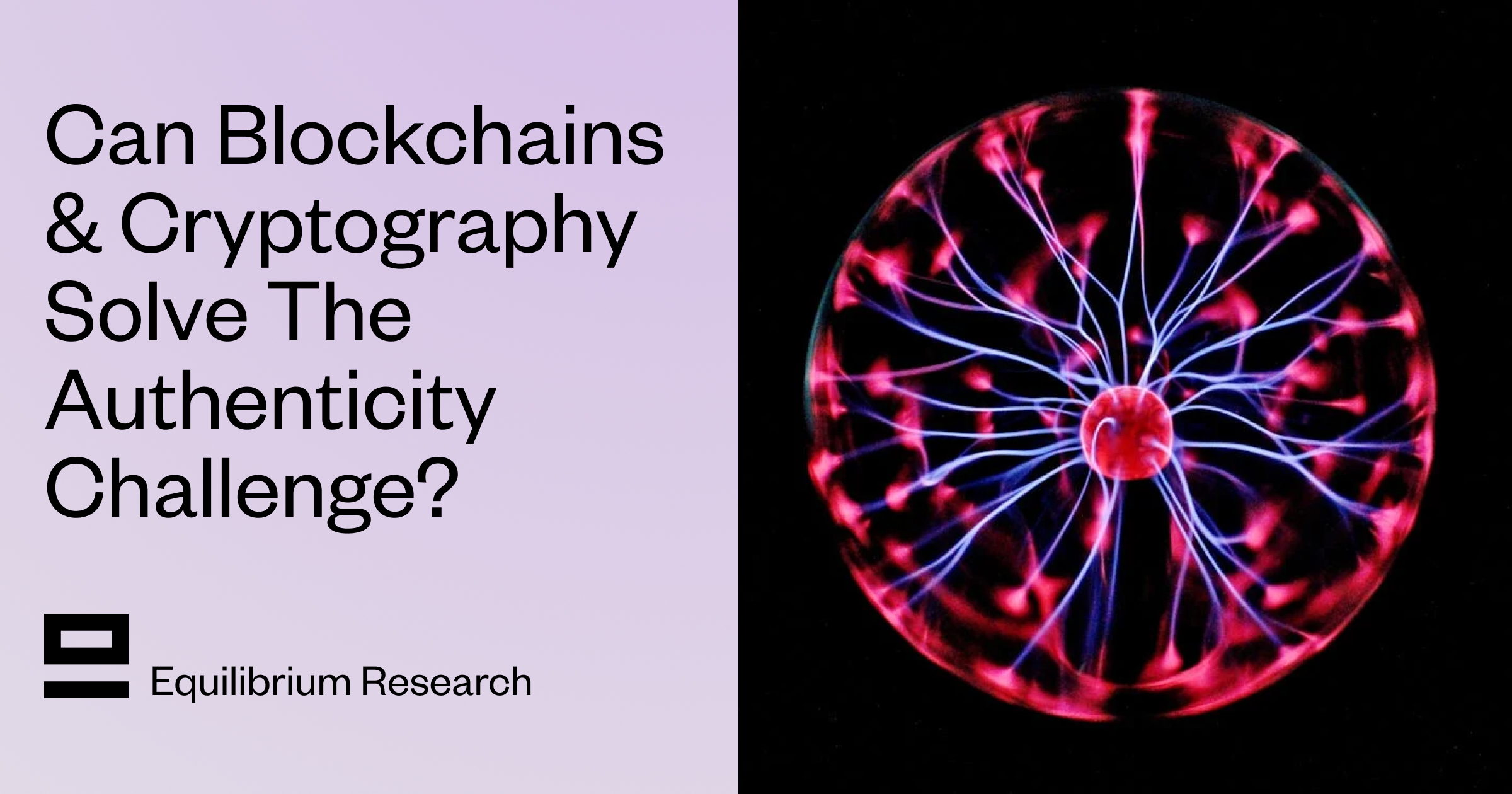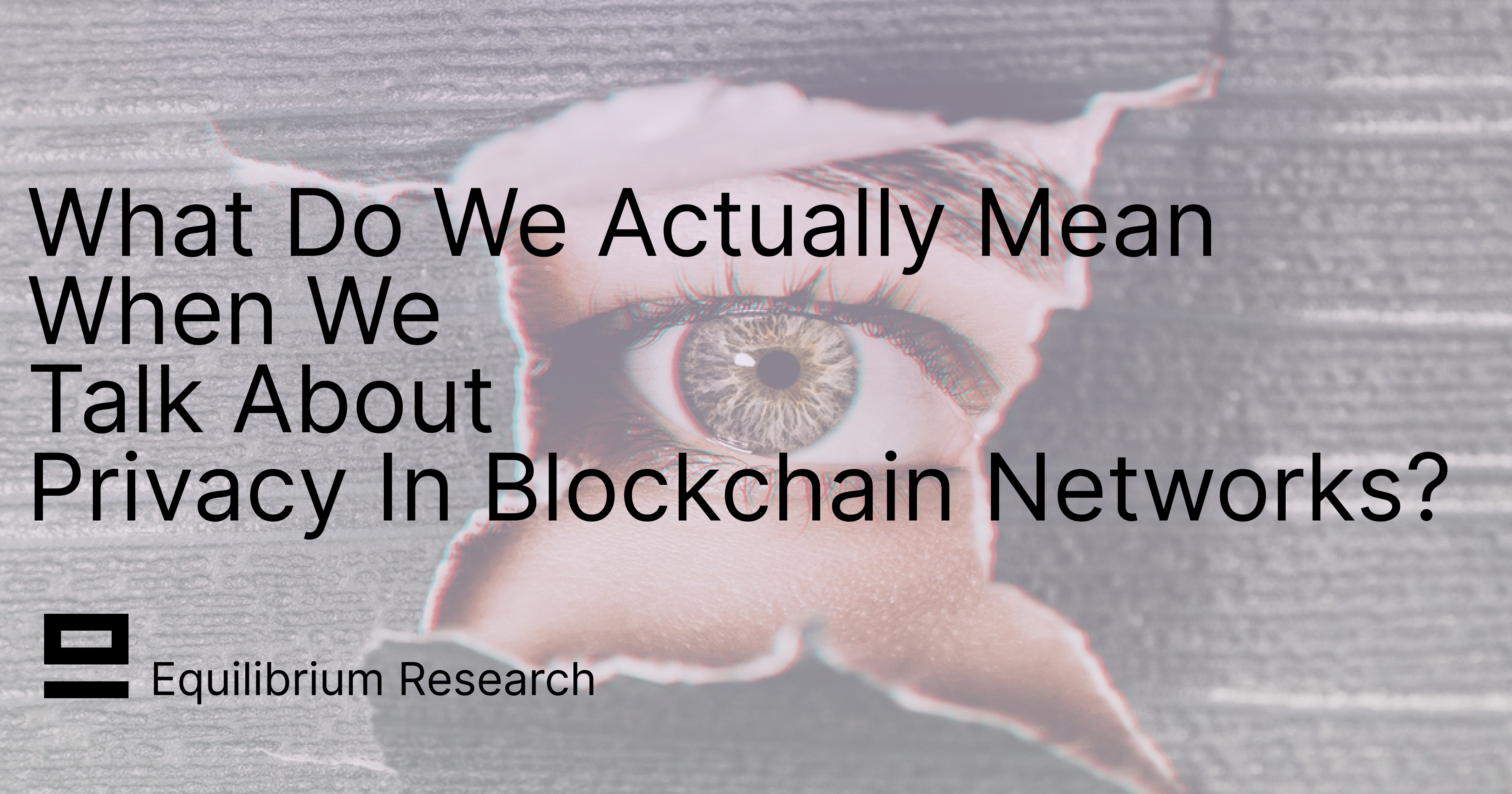
Part one of our privacy series covered the “what, why, and how” of privacy in blockchain networks. Part two examined the endgame for privacy infrastructure, arguing that all roads ultimately lead to MPC.
In the third (and final) part of the series, we explore nine open engineering problems in the blockchain privacy space in addition to touching on the social/regulatory challenges. We’ve also included a small bonus at the end for eager hackers and app developers looking for inspiration.
If you are thinking about any of these problems or are already building a solution, we’d love to hear from you! Equilibrium partners with ambitious founders through R&D, engineering support, or funding through our venture arm (Equilibrium Ventures).
Additional thanks to Ais (Taceo), Lisa (Aztec), and Olli (Equilibrium) for their input and review!
1. Private Proof Markets
ZK-based privacy solutions - both specialized and general-purpose - have two broad options when it comes to generating the ZKP:
Client-side proving: Users generate the ZKPs on their own devices (maximizing privacy guarantees), but performance is limited to consumer hardware.
Outsourcing to a third party: This enables better performance and faster proof generation, but sacrifices privacy as the user needs to send information to the third-party prover who generates the proof.
Private proof markets provide a compromise between these two solutions: The proof generation is delegated to an MPC committee, but no single prover sees the entire information (secret input). The privacy guarantees boil down to those of the MPC committee and it relies on them not colluding.

The main problem with private proof markets is how to reduce the communication overhead of MPC protocols and make the e2e flow more efficient. A team already working on this is Taceo, which recently published a blog post detailing optimizations that reduce the required communication drastically (achieved constant communication, i.e., independent of the number of R1CS constraints). This results in MPC performance being very close to non-MPC performance!
Once an implementation is mature enough, it could be integrated into an existing proof market to enable easy delegation of private proofs. The main question is whether the gains in latency are worth the loss in privacy guarantees, as there is no way to prevent collusion in a fully provable way. The answer to this question will depend on the application.
Key challenge: Increasing efficiency and getting a mature enough implementation that can be integrated into existing proof markets.
Additional resources:
Taceo: The Surprising Efficiency of Honest-Majority MPC for coSNARKs
Scalable Collaborative zk-SNARK: Fully Distributed Proof Generation and Malicious Security
2. Private Shared State For ZK-Based Privacy Blockchains
While ZK-based privacy solutions offer strong individual privacy guarantees, they don’t enable multiple parties to compute over the same piece of private state. This is important for many applications and use cases.
Private shared state can be achieved by combining ZK with MPC (collaborative proving), FHE, and/or TEE. However, combining multiple privacy-enhancing technologies (PETs) introduces additional overhead, complexity, and trust assumptions. In addition, any solution that aspires to provide private shared state without a single point of failure ultimately falls back to the trust assumptions of MPC.
The main challenges here lie in both increasing efficiency to make more use cases practically feasible and building tools so that application developers can easily leverage the technology without having to bother with the underlying cryptography. Directionally, we are on the right track, but there is still a long way to go.
It’s worth noting the difference between private proof delegation (point 1) and private shared state. In private proof delegation, you're doing very specific "MPC-friendly" operations, which means the overhead can be almost zero. Private shared state, on the other hand, is more general-purpose compute and requires a much broader set of operations. This leads to more overhead.
Key challenge: Reducing overhead to make more use cases practically feasible and strengthen privacy guarantees (e.g. by increasing the number of nodes part of the MPC committee).
Additional resources:
3. Accelerating Client-Side Proving On Smartphones
86% of the global population have smartphones today (~7.1bn) and particularly in emerging markets, smartphones are the dominant way for people to access the internet. Conversely, most blockchain applications today still cater to a browser extension on a laptop or desktop computer.
How does this relate to privacy use cases? ZK-based privacy applications rely on client-side proving (proof generated locally on the user’s device). Unless we also focus on smartphones, which can have much worse hardware specs than the average laptop, the UX may be unusable. The heavy proof aggregation work, on the other hand, can be delegated to an external server without sacrificing privacy guarantees.
This is less of a concern for FHE, MPC, or TEE-based private applications where the private computation is delegated. This would also be true for ZK in the case of private proof markets (point 1), but giving users the option to generate proofs client-side is still important.
Existing private applications that are mobile-first are relatively simple (in terms of proof complexity), which is how they achieve low enough e2e latency (proving and verification) so it doesn’t affect the user experience.
One example is the private payments app Payy, which achieves e2e latency of <5s on recent iPhone models and somewhat longer for cheaper Android models. This is primarily due to the small proof size (2^16 constraints), whereas proofs for more complex programs are typically >2^21 constraints. These would take much longer to generate and require more efficient proving algorithms.
Key challenge: Optimizing client-side proving so it's performant enough even with the constraints of lower-end smartphones and cheaper hardware.
Additional resources:
4. Hardware Acceleration
Of the PETs that are most relevant to blockchains, ZK and FHE face the biggest compute bottlenecks and would benefit the most from hardware acceleration:
The current overhead on FHE computation is several orders of magnitude higher than plain execution. This excludes the additional overhead from the MPC decryption network (and potentially verifiability with ZKPs). Examples of teams working on FHE hardware acceleration include Optalysys, fhela, and Niobium.
ZK-based privacy protocols would also benefit from hardware acceleration since only the initial proof needs to be done client-side (or collaboratively with MPC). The generation of aggregation proofs can be outsourced e.g. to a proving network. Teams working on ZK hardware include Fabric Cryptography, Ingonyama, and MayaZK.
The challenge with hardware acceleration for both FHE and ZKP is that the space is still evolving at such a rapid pace that any custom-designed hardware would likely become obsolete quickly (potentially even before it’s released). Therefore, we’ll likely see more focus on software optimization before proving systems become more ossified and the pace of research breakthroughs slows down.
MPC is mainly constrained by communication overhead, which can be reduced with more efficient MPC schemes, preprocessing, and reducing the number of parties included in the cluster. Computation is not a bottleneck for MPC.
Trusted hardware or trusted execution environments (TEEs) already require specialized hardware, so they don’t fit into the discussion here. In addition, TEEs' compute overhead is already relatively low compared to other PETs. Instead, research questions are more about enhancing the privacy and trust guarantees that TEEs can provide.
Key challenge: Balancing the rapid pace of software innovation with the demand for hardware acceleration to make more use cases practically feasible.
Additional resources:
5. Scaling Reads For UTXO-based Privacy Chains
Querying and indexing state (such as account balance) in UTXO-based privacy chains is more complex than sending a request to an RPC node. Telling a public node how to view your data is similar to trusting a third party, significantly weakening privacy guarantees. At this level of privacy guarantees (trusted privacy), other solutions are simpler and more efficient (e.g. A validium with a centralized party storing the data).
Rather than relying on an RPC provider, users sync locally by scanning for records that exist in the append-only database and haven’t yet been used (i.e. don’t exist in the nullifier tree). This is resource-intensive and becomes increasingly difficult as the append-only database (private note tree) grows.
Zcash faced this issue in 2022 when it experienced a massive increase in shielded transaction volume and wallets had trouble syncing. Aztec expects to face similar problems and is taking preventative measures to find a solution. Some proposed solutions include private information retrieval, oblivious message retrieval, or fuzzy message detection.
Key challenge: Ensuring that users and wallets are still able to sync to the chain without having to rely on centralized third parties.
Additional resources:
6. Private Bridges
While the demand for bridging between private chains has been limited thus far, we are now seeing multiple privacy-focused chains launch or be close to launching their mainnet (Namada, Penumbra, Mina, Aleo, Aztec, Polygon Miden…). The future will likely be multi-chain and private (although varying privacy guarantees), requiring bridging between private chains (for example, between Aleo and Aztec).
Most information leaks when moving between shielded sets, yet all solutions today require unshielding before bridging and re-shielding on the other chain. A private bridge would enable bridging between chains without unshielding in between, aiming to maximize privacy and make it harder for unwarranted outside observers to track. This area remains under-explored.
Key challenge: Enabling briding between shielded sets without having to unshield and re-shield in between (leaking information).
Additional resources:
7. Proof of Passport with Biometric Identification
Identity solutions and proof of personhood enable us to leverage real-world identities for on-chain applications, opening the door to new use cases and richer social graphs. However, considering the sensitivity around identity and its misuse, strong privacy guarantees are non-negotiable.
Besides biometric identity methods such as World, another approach that’s gained recent traction is ZK passports. Scanning your passport with NFC and generating a ZKP enables you to prove some aspects of your identity, such as that you own a valid passport and additional metadata (e.g., age, or country of birth), without revealing all the information to the verifier. Protocols working in this category include Rarimo and ZK Passport.
However, existing ZK passport implementations don’t enable proving that it’s your passport or that you are the valid owner of it. This can lead to potential problems around identity theft or markets where malicious parties can buy/rent a digital identity for a specific purpose.
Proving that you are the valid owner of a passport would require some additional biometrics, such as fingerprint or face-ID recognition, to match the data on the passport. The two main challenges with this are:
Computationally intensive: Generating the proof client side on a smartphone is challenging (high complexity). This is particularly true for lower-end smartphones, which are more prevalent in emerging markets.
Existing hardware is not accurate enough: Even if the performance was sufficient to generate a ZKP, smartphone cameras are not necessarily accurate enough for this scanning. Hence, we would require custom hardware such as the Orb by World.
Key challenge: Incorporating biometric identification into the ZKP and proving that you are the valid owner of the passport by using a smartphone (rather than relying on third-party hardware solutions).
Additional resources:
8. Improving Developer Tooling, Standards, and Testing
Existing tooling, libraries, and standards from public chains can’t be imported directly to private chains due to differences in available data, account structure, etc. This makes it much more challenging for developers who want to build private applications since they don’t have familiar tools to rely on (from initial prototyping to developing production-ready code and testing).
While the founding team will often build some of these, in most cases the community and third-party developers are more effective in accelerating the development and diversifying the available toolings.
Companies like Venture23 or Obscura are already working on tooling, oracles, APIs, and various SDKs to simplify the process of building private dApps on Aleo, Aztec, Dusk, and Mina. An example of an independent contributor is Aleo hackathon winner Leology, a Rust-based testing framework that aims to make it faster, easier, and safer to develop programs on Aleo. However, more is needed.
Given that application developers are crucial to making an ecosystem come to life and offering users a wide range of applications, making the developer experience as smooth as possible should be a top priority for all new ecosystems!
Key challenge: Improving developer experience and ensuring developers have all the necessary tools to build private applications.
Additional resources:
9. Compiler for zkDSLs To Enable Writing Private Applications In Common Languages
Most ZK-based programmable privacy protocols have a purpose-built domain-specific language (DSL) for building private applications. These higher-level languages aim to abstract away the complexity of writing ZK circuits.
Some examples of ZK-DSL include Leo by Aleo, Noir by Aztec, and o1js by Mina. While they are built to resemble common languages, like Rust or Typescript, they still require developers to learn a new language and rewrite their codebase. What if you could instead just use a common language?
This is already true for some approaches to programmable privacy. For example, Zama’s fhEVM enables writing private applications in Solidity, meanwhile, Arcium’s MPC-compute network is Rust-based. There is also already a Noir compiler for Solidity.
Key challenge: Balancing the loss in efficiency with removing barriers of entry for new developers.
10. Social, Compliance, and Regulatory Challenges
Privacy is both a social and a technical problem to solve. While a lot of work remains on the technical side, we have a relatively good idea of the roadmap.
The main challenge on the social and regulatory side is particularly for stronger privacy guarantees (non-intermediated) and financial use cases. A secondary challenge is to get people to experiment with privacy in fun ways, such as what Cursive is doing. There are a few approaches to tackle this, which are not mutually exclusive:
Aim for weaker privacy guarantees as an intermediary step: Most privacy projects within crypto today aim for the strongest level of privacy guarantees, i.e. privacy from other users, service providers, and governments/governmental bodies. However, most blockchain interactions today are fully public and visible to all external observers. Perhaps a reasonable first step would be to aim to at least get privacy from other users (“web2 privacy”) rather than jumping straight to the far end.

Work with regulators to educate them: Many organizations and individuals are already working hard on this, including general privacy-focused (such as Electric Frontier Foundation and Internet Society), those focusing on privacy in blockchains (such as web3 privacy and DC Privacy Summit), and those focusing on blockchain more generally (such as Blockchain Association and Crypto Council For Innovation). However, more policy efforts globally will be needed to educate regulators and lawmakers about how privacy-enhancing technologies can be used in blockchains to protect users and enable more innovation.
Challenge existing regulation by building applications with hard privacy guarantees: Any new technology will face resistance from decision-makers, particularly if it risks reducing their power. The most rebellious approach is to do things first and ask for forgiveness later. With enough momentum and user adoption, one can be in a much better position to negotiate and affect the regulatory landscape. This is how technology typically evolves.
Bonus: RFPs and Ideas From Projects and Ecosystems
If you are looking for inspiration on applications to build or a hackathon project, the list below can act as a guide:
Noir Research Grant proposals: NRG #1 zkEmail and NRG #2: Private Shared State
Web3 Privacy: Privacy Idea Generator
Continue reading

May 28, 2025
State of Verifiable Inference & Future Directions
Verifiable inference enables proving the correct model and weights were used, and that inputs/outputs were not tampered with. This post covers different approaches to achieve verifiable inference, teams working on this problem, and future directions.

March 25, 2025
Introducing Our Entrepreneur in Residence (EIR) Program
After 6+ years of building core blockchain infrastructure across most ecosystems and incubating ventures like ZkCloud, we're looking for ambitious pre-founders with whom to collaborate closely.

March 10, 2025
From Speculation to Utility: Next Steps For Onchain Lending Markets
Despite its promises, onchain lending still mostly caters to crypto-natives and provides little utility besides speculation. This post explores a path to gradually move to more productive use cases, low-hanging fruit, and challenges we might face.

February 18, 2025
Can Blockchains And Cryptography Solve The Authenticity Challenge?
As gen-AI models improve, it's becoming increasingly difficult to differentiate between AI- and human-generated content. This piece dives into whether cryptography and blockchains can solve the authenticity challenge and help restore trust on the Internet

February 6, 2025
Vertical Integration for both Ethereum and ETH the Asset
In recent months, lackadaisical price action and usage growing on other L1/L2s has driven a discussion on what Ethereum’s role and the value of ETH, the asset is long-term.

January 29, 2025
Equilibrium: Building and Funding Core Infrastructure For The Decentralized Web
Combining Labs (our R&D studio) and Ventures (our early-stage venture fund) under one unified brand, Equilibrium, enables us to provide more comprehensive support to early-stage builders and double down on our core mission of building the decentralized web

November 28, 2024
20 Predictions For 2025
For the first time, we are publishing our annual predictions for what will happen by the end of next year and where the industry is headed. Joint work between the two arms of Equilibrium - Labs and Ventures.

October 15, 2024
Aleo Mainnet Launch: Reflecting On The Journey So Far, Our Contributions And Path Ahead
Equilibrium started working with Aleo back in 2020 when ZKPs were still mostly a theoretical concept and programmable privacy in blockchains was in its infancy. Following Aleo's mainnet launch, we reflect on our journey and highlight key contributions.

August 12, 2024
Do All Roads Lead To MPC? Exploring The End-Game For Privacy Infrastructure
This post argues that the end-game for privacy infra falls back to the trust assumptions of MPC, if we want to avoid single points of failure. We explore the maturity of MPC & its trust assumptions, highlight alternative approaches, and compare tradeoffs.

June 12, 2024
What Do We Actually Mean When We Talk About Privacy In Blockchain Networks (And Why Is It Hard To Achieve)?
An attempt to define what we mean by privacy, exploring how and why privacy in blockchain networks differs from web2, and why it's more difficult to achieve. We also provide a framework to evaluate different approaches for achieveing privacy in blockchain.

April 9, 2024
Will ZK Eat The Modular Stack?
Modularity enables faster experimentation along the tradeoff-frontier, wheras ZK provides stronger guarantees. While both of these are interesting to study on their own, this post explores the cross-over between the two.

October 5, 2023
Overview of Privacy Blockchains & Deep Dive Of Aleo
Programmable privacy in blockchains is an emergent theme. This post covers what privacy in blockchains entail, why most blockchains today are still transparent and more. We also provide a deepdive into Aleo - one of the pioneers of programmable privacy!
March 12, 2023
2022 Year In Review
If you’re reading this, you already know that 2022 was a tumultuous year for the blockchain industry, and we see little value in rehashing it. But you probably also agree with us that despite many challenges, there’s been a tremendous amount of progress.

May 31, 2022
Testing the Zcash Network
In early March of 2021, a small team from Equilibrium Labs applied for a grant to build a network test suite for Zcash nodes we named Ziggurat.

June 30, 2021
Connecting Rust and IPFS
A Rust implementation of the InterPlanetary FileSystem for high performance or resource constrained environments. Includes a blockstore, a libp2p integration which includes DHT contentdiscovery and pubsub support, and HTTP API bindings.
June 13, 2021
Rebranding Equilibrium
A look back at how we put together the Equilibrium 2.0 brand over four months in 2021 and found ourselves in brutalist digital zen gardens.
January 20, 2021
2021 Year In Review
It's been quite a year in the blockchain sphere. It's also been quite a year for Equilibrium and I thought I'd recap everything that has happened in the company with a "Year In Review" post.
